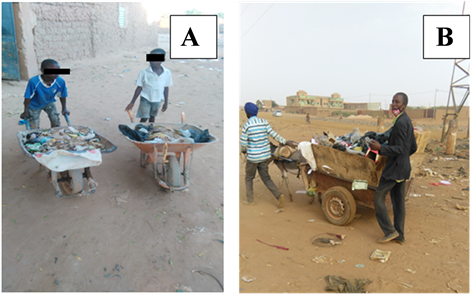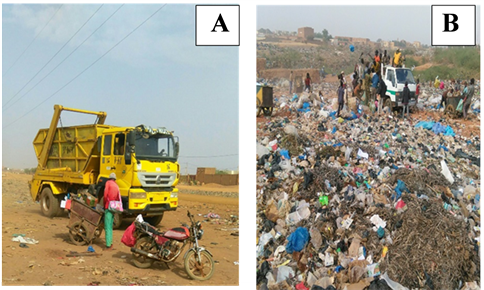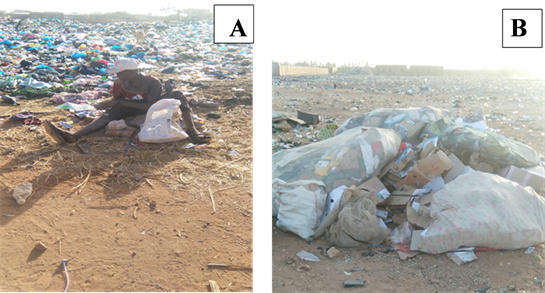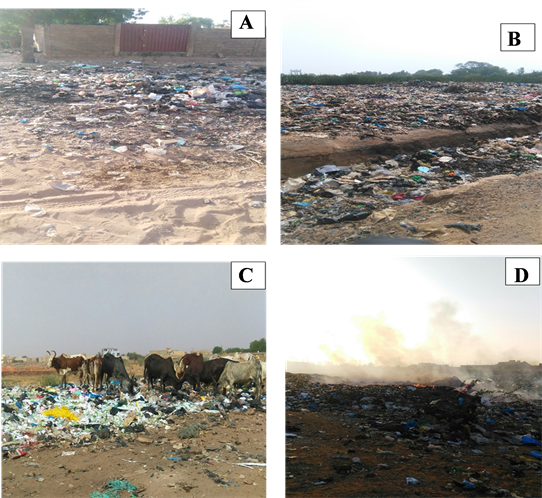Overview of Attitudes and the Household Solid Waste Management System in Niamey, Niger: Opportunities and Impacts ()

1. Introduction
With daily consumption more and more diversified all over the world, the production of waste continues to increase exponentially at the planetary level, thus generating enormous risks for the environment and, consequently, for the health of the populations. This situation is much more worrying in developing countries, mainly because of the considerable delay in the field due to their lack of means and difficulty tackling the issue with an integral approach. In Africa, waste management, in general, and solid waste management, is a challenge closely linked to lifestyles, the accelerated demographic growth of urban areas, the lack of an adequate household solid waste management policy, and the inadequacy of appropriate infrastructure [1] . The problem of waste, although universal, is different in all regions of the world [2] . Managing household solid waste is quite simple, and many countries such as Ghana, Burkina Faso, and Benin have found the solution [3] . In reality, the issue of solid waste is much more complex because political leaders, researchers and experts, municipal technicians, and private operators in waste management have yet to find a satisfactory solution for most of the population. The lack of financial resources is the main reason for this failure [4] . The lack of appropriate infrastructure often exacerbates this situation due to unchecked and poorly controlled urbanization [5] . The city of Niamey, the capital of Niger, is no exception to the issue of household solid waste management. The annual production of a type of waste has increased from 264,444 tons in 2008 to 318,141 tons in 2012, for a collection rate of about 47% [5] . The rest of the waste is then piled up at the level of wild dumps in public spaces and sometimes near homes, creating conditions favorable to the development of vectors of diseases such as malaria or cholera with, as a consequence, a deterioration of the framework and living conditions of populations and the environment [3] . Despite the efforts of municipal officials who are in charge of evacuating all the waste from the city of Niamey and the advent of the Niamey Nyala program, the waste management situation in the capital remains to be improved. Indeed, waste is only sometimes grouped in garbage bins or at the level of the official regrouping places. This constitutes a source of environmental and health risks for the same populations that produce the waste. The Niamey I Communal District is one of the five communes in the Nigerien capital that make large quantities of solid waste, mainly because of the large influx of people and the emergence of small businesses. Waste management in this capital district is poor, and the trend is worrying. In this context, the present study was initiated to establish a diagnosis of solid waste management in this Communal District of Niamey I and its impacts.
2. Method
2.1. Presentation of the Area of Study
The Niamey 1 communal district is located in the western part of the city of Niamey. The Niamey 1 communal district area is estimated at 114 km2 (PDC, 2011).
The Niamey 1 communal district (ACN I) comprises twenty-four (24) administrative villages and neighborhoods (Figure 1).
Administrative villages: Goudel, Yantala, Lossagoungou, Kosseye, Gabagoura,
![]()
Figure 1. Geographical location of the Communal District of Niamey I.
Tondibiya, Soudouré, Tondikoirey, and Gorou Banda.
Neighborhoods: Bobiel, Koira Kano 1, Koira Kano 2, Koira Kano Nord, Koubia, Yantala Plateau, Yantala Recasement, Yantala Riyad, Yantala Bas, Yantala Haut, Foulan Koira.
Village/neighborhood dismemberments: Goudel Gorou, Cité Francophonie, Bobiel 1, Bobiel 2 (PDC, 2011).
2.2. Sampling
The sampling unit considered in this study is the household. Seven neighborhoods in ACN I were chosen for this study. These are the neighborhoods of Goudel, Yantala, Lossagoungou, Kosseye, Gabagoura, Koubia, and Sonuci. The method used consists of three levels of stratification considered necessary in the sanitation conditions of a household (Diallo, 2006), cited by Kamto [6] . These are:
- Subdivision of the area (subdivided area and un-subdivided area).
- Survey neighborhood.
- Type of housing: low-rise, medium-rise, and high-rise.
The technique calculates the sampling frame according to the ratio between the probability of a household belonging to a neighborhood (α1 = 1/7) and a standing (α2 = 1/3). This sampling frame (α) is multiplied by the number of families to obtain the sample size.
α = α1 * α2 (1)
α = 1/7 * 1/3 = 1/42
α = 1/21 ?
which is the sampling frame for the household-level sample.
Table 1 shows the number of households in the sample for each neighborhood included in this study.
Thus, the total number of households in the survey sample was 411. Interviews were also conducted with five pre-collectors found at two landfills and five reclaimers.
2.3. Surveys and Field Observation
Data collection was based on surveys and field observations. The surveys were conducted randomly and individually, using survey forms addressed to the heads of households or any adult in the family willing to answer the questions. The different aspects covered in the questionnaires allow us to understand the respondents’ attitudes, behaviors, and practices about solid waste and their roles in the sector. The questionnaires include both closed-ended and open-ended questions depending on the information sought. The questionnaires for the pre-collector surveys allow for an understanding of their role in the waste stream and the difficulties encountered during pre-collection. For the collectors, the questionnaires addressed aspects related to their working conditions and the different collection products. The communal district Niamey hygiene and sanitation department had other operators involved in the waste collection at the landfill sites. The survey was carried out according to the availability of reclaimers to
![]()
Table 1. Sample size represented by a neighborhood.
provide information. Field observations were conducted throughout the waste management chain. They focused on the practices used by the actors, from pre-collection to landfilling and recovery.
2.4. Data Processing and Analysis
All data collected during the observations, interviews, and household surveys were entered and processed using the software. Statistical analysis of the questionnaire and characterization forms was done using Excel under Windows XP and SPSS 2.0.
3. Results and Discussion
3.1. Municipal Solid Waste Management System
Field observations revealed that pre-collection, collection, transport, and dumping constitute the different stages of the household solid waste management process in the Niamey I communal district. Thus, in the pre-collection, two types of pre-collection have been observed. The first type is a voluntary collection. Residents carry their waste using half-bins, aluminum or plastic buckets, wheelbarrows, or other containers to a container or collection area just a short distance from their homes, usually less than 250 m (Photo 1(A)). The second type is the door-to-door collection, which is handled by the informal sector. In this type of organized pre-collection, micro-enterprises, associations, or neighborhood committees are used to collect waste using a simple transport system such as rickshaws, animal-drawn carts, or human-drawn carts (Photo 1(B)).
The collection of waste is similar to that of grouping containers containing waste and transferring their contents into the collection bins installed by the City Council (Photo 2(A)). This grouped waste is transported to landfills, also used as disposal sites. The latter is only unused spaces or former quarries that have become large untreated ravines. These dumps are located all around the city and constitute a real threat to the environment and the local inhabitants. Thus, the analysis of the waste management system in the Niamey I Municipal District shows that households produce enormous quantities of waste in their daily lives. However, waste management is a growing concern in this part of the Nigerien capital. Indeed, it was found that households accumulate and abandon garbage in the streets, on vacant lots, and in public places such as neighborhood markets and open gutters (Photo 2(B)). This situation is similar to that experienced in Kinshasa, more precisely in the Commune of Limete, described by Likoli [7] . According to this author, in almost all the markets of this commune, mounds of garbage litter the aisles of the food sales areas. However, this situation is not homogeneous in all the communes of the same city. In fact, according to Lelo [8] , 91% of households in the Commune of Ngaliema have plot gardens in which they bury their household waste. This situation shows diverse waste collection and disposal methods in large African cities, but they all present health and environmental risks.

Photo 1. (A) Voluntary pre-collection in the Gaba Goura neighborhood. (B) Door-to-door pre-collection on a donkey cart in the Goudel neighborhood.

Photo 2. (A) Poly-truck for waste transportation. (B) Former quarry transformed into a landfill in Goudel.
3.2. Household Solid Waste Management at the Household Level
The results of the surveys show that 50% of households do not subscribe to pre-collection operators for household solid waste. They dispose of their trash themselves. On the other hand, 38% of respondents entrust the removal of their waste to informal pre-collection services, compared to 12% who subscribe to private operators (Figure 2).
Analysis of Figure 2 shows that 88% of households entrust their waste to informal collection operators, i.e., not authorized by the municipality or to primarily young family members (Photo 1). This situation is explained by households investing less in waste management. Also, informal operators do not apply fixed tariffs (from 150F CFA) to remove waste outside the concessions. The latter operates mainly in working-class neighborhoods (low status). In addition, private operators offer a contract for household waste removal at an average rate of 2000 CFA francs per month. The clients of these operators live in medium to
![]()
Figure 2. Distribution of households subscribing to pre-collection services for household solid waste.
high-class neighborhoods. The data obtained on households subscribing to legal collection services are reminiscent of Zakari [9] , who studied household solid waste management in the commune of Kandi in Benin. The latter reports that 32% of households subscribe to legal solid waste collection services. They are also close to those of Penda [5] , who obtained 42% of households subscribing to legal pre-collection services in the Niamey IV Communal District. This situation results in the dumping of solid household waste in inappropriate places since the disposal of garbage outside households is entrusted to children, leading to the uncontrolled proliferation of this waste. Field surveys among households have given us an idea of the types of pre-collectors who ensure the disposal of their household solid waste. There are two types of service providers, depending on their status vis-à-vis the municipality: private operators recognized by the municipal authorities (Photo 3(A)) and informal service providers (Photo 3(B)). The results of the surveys showed that almost all the population claims to be responsible for the disposal of household solid waste outside their concessions. However, depending on the household’s standard of living, responsibility for household solid waste disposal varies (Table 2). Low-income families claim to be responsible for the disposal of household solid waste at the nearest collection point.
The analysis in Table 2 indicates that 96% of upper-class households entrust their waste to private operators because of their standard of living and lifestyle. On the other hand, private operators are less sought after by households in working-class neighborhoods (low status), as only 6% of these households subscribe to these operators because of the tariffs applied. The latter prefer to leave their waste disposal to children, as shown in Photo 1. In Nairobi, [10] assessed the knowledge of residents on the identity of solid waste management service providers in their area. About 53.4% of the households surveyed indicated that private collectors were primarily responsible for waste collection at the household level.
On the other hand, 30.5% of the residents noted that the municipality was responsible, while 7.6% indicated that the collectors were persons unknown to the
![]()
Table 2. Households’ perception of the roles of the actors in household solid waste collection.

Photo 3. Private pre-collectors (A) formal service in Losso Goungou (B) informal service in Sonuci.
residents. However, 3.4% of the respondents showed no knowledge of the waste collection actors in their area. According to their results, household waste is placed at a central collection point in bags, plastic containers, and metal bins, as well as in dumpsters awaiting collection by private service providers and the City Council before dumping. However, the collection facility(ies) are inadequate, resulting in solid waste accumulation. The surveys showed that official pre-collection operators in the Niamey I Communal District charge the same price for solid waste disposal, i.e., 2000 CFA francs/month/household. In contrast, informal service providers charge variable costs depending on the quantity of waste disposed of. Prices vary between 150 and 1500 CFA francs, according to interviews.
The results of the pre-collector surveys show that the prices charged in Niamey I are lower than in the Commune of Abomey Calavi [11] . In this commune, monthly collection fees vary from 1500 to 3500 CFA francs, depending on the type of housing. They are also lower than in Bamako, which ranges from 1500 to 3000 CFA francs per concession [12] . In Bamako, these authors also found that collection fees are slightly higher in the gridded areas, with a monthly cost of 4000 to 5000 CFA francs for the more significant concessions that produce more waste.
3.3. Waste Valorization
The results of the study also show that there is an informal household solid waste recovery system in the Niamey I Municipal District. Indeed, it was found that waste pickers also operate in this district. The waste collected on the dumpsites includes:
● Metal objects (cans, motorcycle or car parts, etc.).
● Plastic objects (juice or mineral water bottles).
● Cardboard (Photo 4(A), Photo 4(B)).
According to interviews with the collectors, the different prices of the objects collected are 200 CFA francs per kilogram of metal objects, 25 CFA francs per 50-centiliter bottle of soft drink, and 15 CFA francs per kilogram of cardboard. The costs these reclaimers charge are higher than those reported by Mbiadjeu-Lawou et al. [13] in Bangangté in Cameroon, where a bottle of mineral water costs between 15 and 20 CFA francs and metal costs 75 CFA francs per kilogram. The fees charged by reclaimers in the Niamey I communal district are still higher than those in the Niamey IV communal district, where the price of the metal recovered ranged from 65 to 75 CFA francs per kilogram [5] . It is thus easy to see that this form of recovery can generate income and reduce the quantity of waste but also presents health risks for the latter.
3.4. Impacts of Household Solid Waste Management
The problem of the final destination of waste in Niamey is acute. Indeed, from independence in the 1960s to today, the city has no official landfill that meets environmental standards. The study found that 95% of respondents knew household solid waste could impact human and animal health and the environment. They affirmed that the proliferation of unauthorized dumps everywhere in front of peripheral habitats of the commune (Photo 5(A)), in gutters (Photo 5(B)), and unbuilt plots of land in their commune constitutes an environment favorable

Photo 4. Waste recovery at communal dumping sites: (A) Recoverer at a dump in the Koubia area. (B) Deposit of cardboard recovered at the Sonuci dump.

Photo 5. Garbage dumping in the Niamey communal district: (A) Cattle grazing on a wild dump in the Koubia area. (B) Incineration of garbage in a Sonuci dump. (C) In front of a concession in the Koubia area. (D) In a rainwater drainage channel in the Goudel area.
to the multiplication of germs responsible for all types of diseases and infections (tetanus), as well as arthropods (flies, mosquitoes) and rodents. Field observations have shown, moreover, that the most exposed population is the one that is economically the most vulnerable and the most disadvantaged. It was also observed that poor people and animals squat in these unhealthy places in a rave (Photo 5(C)). The last feed continuously on the dumps and, through a phenomenon of bioaccumulation, are likely to store large quantities of toxic and non-biodegradable products. The meat consumption of these animals can constitute a form of transfer of these toxins to humans. The most common method of waste disposal in this municipality is incineration (Photo 5(D)), which contributes to the pollution of the atmosphere through the release of smoke containing large quantities of pollutants. It was also noted that waste is often disposed of by dumping it in gutters, producing leachate that can seep into the water table or run off into streams. The impacts related to household solid waste management in Niamey I commune are similar to those observed in Tizzi-Ouzou in Algeria reported by Maamar and Kechout [14] . These authors have shown that household solid waste is a source of air pollution during incineration because it emits many gases such as methane, carbon dioxide, and chlorofluorocarbon, which can increase the greenhouse effect and global warming. The results of the study by Souaibath [15] confirm these impacts and mention that these wastes mixed with human or animal excrements generate olfactory nuisances and cause the proliferation of pathogens responsible for diseases such as malaria, cholera, typhoid, and paratyphoid fever, dysentery, infantile diarrhea, and other intestinal infections.
4. Conclusion
The study showed that the solid household waste management system in the Niamey I Municipal District is poorly managed and is characterized by the absence of a rigorous control framework. Indeed, all the management stages are not appropriate and remain risk factors for public health through the degradation of the quality of the living environment of the population and the environment. The lack of technical and financial means does not allow the municipal sanitation service to operate correctly in this management. Also, the low income of the population, associated with the people’s negligence, constitutes an obstacle to the good practice of this waste management. This leads to the multiplication of uncontrolled dumps on the roads, in the gutters, and in the undeveloped peripheral neighborhoods, but also to the emergence of uncontrolled landfills, sources of various health and environmental risks. The study showed that reclaimers and pre-collectors are equally essential actors in the household solid waste management chain. Therefore, they must be considered in the local solid waste management plans as strategies for improving sustainable waste management in the Niamey I Municipal District. In addition, it is essential to involve the population in waste disposal. Their knowledge of solid waste management supports changing their attitudes toward maintaining a clean environment.